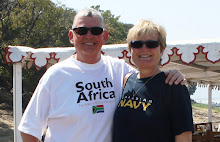If the
current state of the world economy has affected Bermuda its hard to
tell by the elegant homes, manicured lawns and yachts that
greeted us as we sailed into Hamilton.
We docked
in the centre of town at Front Street, an area of well-patronized shops and
restaurants - even a Marks and Spencer.
With most goods imported from the UK and Ireland, prices are high. That coupled with a median house price of
$1 Million and gas selling for $9 a gallon, Bermuda is an expensive place to
live.
 |
| Hamilton Waterfront Home |
Walking
through the main shopping area vehicle traffic moved
efficiently - a mixture of compact cars and trucks and a veritable sea of
scooters.
A small bus depot in the heart
of town disgorges its blue and pink buses to all parts of the island - the bus
service does well since residents are only allowed to own one car, but as many
scooters as they like.
And then I
spotted my first one: a businessman in
Bermuda shorts with long socks to the knee and of course jacket, crisp shirt
and tie. He carried a briefcase, wore a
smart hat and obviously had places to go.
 |
| Trooping the Colour on Front Street |
Hamilton’s very existence stems from Bermuda’s privateering history. The island's reefs caused the demise of many a sailing vessel bound for the New World. The booty rescued from
shipwrecks was redistributed by privateers who agreed to pay the
appropriate taxes to the authorities for their haul. However, Bermuda’s original capital of St. George’s was just too far away for the powers of the day to collect the taxes from what in
effect was sanctioned piracy. So the
capital moved to Hamilton.
 |
| St. Peter's Church |
Hamilton is
a smart little town that bustles with activity, but the jewel of the island in
St. George’s. Founded in 1612 and the
oldest continuously inhabited England settlement in the Western hemisphere, St.
George‘s is reminiscent of a Cornish seaside town with its pretty church of St
Peter’s and attractive buildings. St. George’s is a community of
colourful cottages awash in pastel colours.
All bear the same ridged rooflines covered with white limestone designed
to reflect the heat but most importantly to collect rainwater. There are no rivers or streams on
Bermuda.
As we
examined the well-worn headstones in St. Peter’s graveyard, the Minister,
looking sporty in his Bermuda shorts passed us and wished us a pleasant good
morning. The headstones do an effective
job of telling the island’s past, the graveyard the final resting place for the
rich and powerful as well as slaves and privateers.
 |
| Ceremonial Stocks |
St. George’s winding cobble-stoned streets and
alleys converge into the main square where ceremonial stocks and a ducking
stool serve as a reminder of how punishment was once meted out to non-compliant citizens.
Driving
south west from St. George’s to Tucker's Town one realizes what real money can lease.
 |
| On St. George's Waterfront |
Despite the fact that many of the
homes cost upward of $20 Million, there are strict residency laws in Bermuda
and a 99 year lease is the best an offshore billionaire can do. The ranks of Tucker's Town’s well-known
residents include international politicians, movie stars and sporting
celebrities. The community’s golf course
is immense and pristine even though roosters and chickens roam the greens at
will, disinterested in the cost of the high-priced grass they are scratching
through.
 |
| Hamilton Waterfront Home |
Bermudans
value tourist trade - after all with no income tax visitors provide healthy
tax revenues to the Island.
Everyone we met was
friendly and helpful - when we couldn’t find a public
washroom in St George’s, the local postmistress beckoned us into her office to
use the post office’s facilities.
Stepping over unopened mailbags we thanked her profusely.
As the ship
slipped its moorings from Hamilton’s Front Street at the end of our stay, three
scantily clad teenage girls waved frantically as we pulled away. They shouted
“we hope you had a good
time!”
We had.








No comments:
Post a Comment